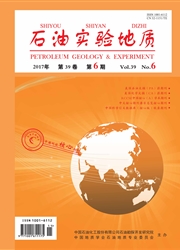

 中文摘要:
中文摘要:
准噶尔盆地温压系统的形成与演化对油气远源成藏具有明显的控制作用。以系统热力学理论为指导,在盆地温度场和压力场分析基础上,系统研究了盆地温压系统的特征、演化及其对油气远源成藏的控制作用。研究表明盆地隆起区具有高地温、高地温梯度和高大地热流的特征,坳陷区则相反;坳陷区普遍发育超压,并向盆地边缘呈不规则环状降低,盆地南部及腹部坳陷区发育强超压,盆地东部次之,西北缘以弱超压为主。垂向上盆地发育P-T3、J1-J1s和K1tg-E2-3a三套相对封闭的温压系统。海西期盆地沉降速率较快,P-T3期温压系统超压积聚;至燕山期构造运动强烈,凸起边缘切穿盖层的断裂活动频繁,地层温压场调整,油气突破盖层运移与聚集,是该区远源油气藏形成的主要时期;喜马拉雅期盆地主要为南降北升的掀斜运动,断裂活动微弱,相对封闭性温压系统的发育使油气保存条件优越。平面上远源岩性油气藏主要分布在盆地西北缘、莫北―莫索湾地区、陆梁隆起及东部隆起等低温压场区,是准噶尔盆地远源油气藏勘探的有利区。
 英文摘要:
英文摘要:
The controls ol the formation and evolution ol the temperature-pressure system on a far-source hydrocarbon accumulation in the Junggar Basin were studied systematically based on the analyses ol temperature and pressure fields and guided by the theory ol system thermodynamics. The uplifted area ol the basin is featured by high temperature, high temperature gradient and high heat flow, while the depressed area is opposite. Overpressure developed in the depressed area and decreases in irregular rings to the edge ol the basin. Strong overpressure developed in the south ol the basin and the central depressed area, medium overpressure developed in the east ol the basin, and weak overpre-ssure developer! on the northwestern margin ol the basin. Vertically there are three sets ol relatively closer! temperature- pressure systems in the basin: the Permian-Upper Triassic system, the L^)wer Jurassic system and the Cretaceous- Paleogene system. The sedimentation rate ol the basin was relatively last during the Hercynian period, and the energy accumulation ol temperature and pressure took place from the Permian to the Late Triassic. Tectonic movements were intense in the Yanshanian period, and fracture activities cut through cap rocks frequently at the edge ol the uplifts. The temperature-pressure field adjusted, leading to oil and gas migration and accumulation through cap rocks. It was the main period lor the formation ol far-source reservoirs. The basin was tilting, descending in the south and uplifting in the north, in the Himalayan period, and fault activity was weak. The temperature-pressure system was relatively stable and helped oil and gas preservation. The far source lithologic oil and gas reservoirs are mainly distributed in the low-energy field ol temperature-pressure in the horizontal, such as the northwest ol the basin, Mobei-Mosuowan area, Luliang uplift and the eastern
 同期刊论文项目
同期刊论文项目
 同项目期刊论文
同项目期刊论文
 期刊信息
期刊信息
